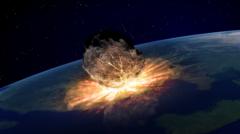Scientists have uncovered groundbreaking evidence that a massive meteorite impact, which occurred three billion years ago, not only reshaped the Earth but played an unexpected role in facilitating the development of early life. The meteorite, named S2, measured 40-60 kilometers in diameter—significantly larger than the one responsible for the extinction of the dinosaurs—and its collision left a vast 500-kilometer crater.
The research team led by Nadja Drabon from Harvard University journeyed to the Eastern Barberton Greenstone Belt in South Africa, where they painstakingly collected rock samples to analyze the cataclysmic aftermath of the S2 impact. Armed with sledgehammers and accompanied by park rangers for protection against wildlife, they retrieved hundreds of kilograms of spherule particles—tiny remnants of the meteorite's impact.
When S2 crashed into the young Earth, it released an extraordinary amount of energy, causing a violent tsunami that disrupted the seabed and resulted in oceans boiling and evaporating. It is believed this event generated immense heat—raising air temperatures by up to 100°C—and caused clouds of molten rock to rain down upon the surface. In the aftermath, it appeared that early life, composed primarily of single-celled microorganisms, not only survived but thrived, as essential nutrients were churned up from the depths of the oceans.
Prof. Drabon explains, “Life was not only resilient, but actually bounced back really quickly and thrived.” This process of nutrient mixing, akin to a giant fertilizer application to the planet, provided vital minerals such as phosphorus and iron that supported microbial life. The tumultuous conditions that followed the impact ironically fostered an environment conducive to the flourishing of these ancient organisms, challenging previous assumptions that massive impacts were solely catastrophic.
According to the findings published in the journal PNAS, this casts doubt on the historical narrative that asteroids, specifically large ones, uniformly decimated primitive life. Instead, evidence suggests that early life was nourished by the debris and disturbances caused by the meteorites, creating conditions favorable for survival and reproduction in this harsh post-impact world. The research exemplifies the complex dynamics between destruction and creation in the history of Earth's biological evolution.


















